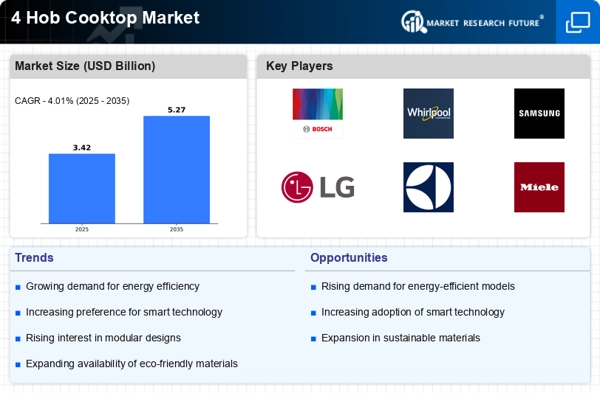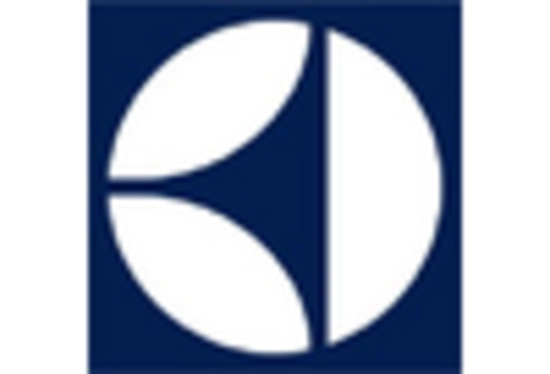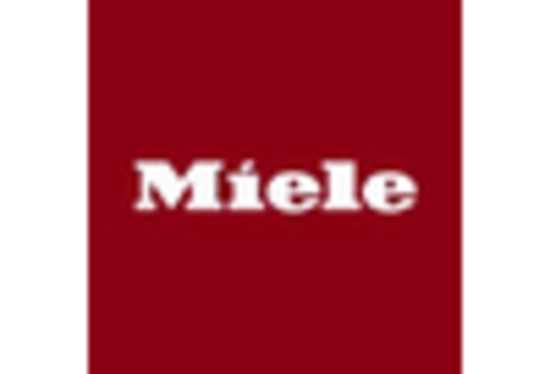Urbanization and Space Constraints
The ongoing trend of urbanization significantly influences the 4 Hob Cooktop Market. As more individuals move to urban areas, the demand for compact and multifunctional kitchen appliances increases. In densely populated cities, space constraints necessitate the adoption of cooktops that maximize cooking efficiency without compromising on performance. The 4 Hob Cooktop, with its ability to accommodate multiple cooking tasks simultaneously, aligns well with the needs of urban dwellers. Market data indicates that urban households are more likely to invest in versatile cooking solutions, suggesting a potential growth trajectory for the 4 Hob Cooktop Market as urbanization continues to rise.
Rising Demand for Energy Efficiency
The 4 Hob Cooktop Market is experiencing a notable shift towards energy-efficient appliances. Consumers are increasingly prioritizing products that minimize energy consumption, driven by rising energy costs and environmental concerns. According to recent data, energy-efficient cooktops can reduce energy usage by up to 30%, appealing to eco-conscious buyers. This trend is further supported by government incentives promoting energy-efficient home appliances, which may enhance market growth. As manufacturers innovate to meet these demands, the 4 Hob Cooktop Market is likely to see a surge in the development of models that incorporate advanced energy-saving technologies, thereby attracting a broader customer base.
Increased Focus on Kitchen Aesthetics
The aesthetic appeal of kitchen appliances is becoming increasingly important in the 4 Hob Cooktop Market. Consumers are not only looking for functionality but also for designs that complement their kitchen decor. The trend towards open-concept living spaces has heightened the visibility of kitchen appliances, making design a critical factor in purchasing decisions. Manufacturers are responding by offering a variety of styles, finishes, and customizable options to meet diverse consumer preferences. This focus on aesthetics is likely to drive sales in the 4 Hob Cooktop Market, as consumers seek products that enhance the overall look and feel of their kitchens.
Growing Culinary Enthusiasm Among Consumers
The rise in culinary enthusiasm among consumers is significantly impacting the 4 Hob Cooktop Market. As more individuals take an interest in cooking and gourmet meal preparation, the demand for high-quality cooking appliances increases. This trend is reflected in the growing popularity of cooking shows and online culinary classes, which inspire consumers to invest in better kitchen equipment. Market analysis suggests that households are willing to spend more on premium cooktops that offer advanced features and superior performance. Consequently, the 4 Hob Cooktop Market is likely to benefit from this shift, as brands cater to the needs of aspiring home chefs.
Technological Advancements in Cooking Appliances
Technological innovation plays a crucial role in shaping the 4 Hob Cooktop Market. The integration of smart technology, such as app-controlled cooktops and touch-sensitive controls, enhances user experience and convenience. Recent advancements have led to the development of induction cooktops that offer precise temperature control and faster cooking times. This technological evolution not only attracts tech-savvy consumers but also positions the 4 Hob Cooktop Market as a leader in modern kitchen solutions. As manufacturers continue to invest in research and development, the market is expected to witness an influx of innovative products that cater to evolving consumer preferences.

















Leave a Comment